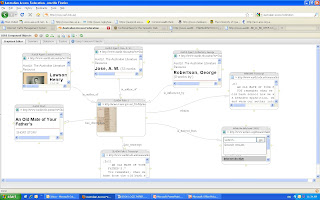The primary social networks of Australian literature have been well defined in research conducted during the last fifty years, but the validity of these networks and their hidden complexity have not been explored. AustLit data can be used to visualise relationships between people and organisations, but the data model does not extend beyond fundamental bibliographical descriptions such as "also writes as", "influenced by", "co-author with".
Visualisation of these relationships has been achieved by drawing on such connections within AustLit, but LORE promises to extend this by enabling researchers to enhance and add relationships with additional descriptions that can better define the social structure of publishing. For instance, the structure of a publisher or periodical can be enhanced by using terms such as "employed by", "literary editor of", "acquaintance of", "father of", "mother of" "literary agent of", "mentor of" etc. Settling on the appropriate terms for the study of publishing is not easy and probably would never stop as unique circumstances arise that better describe certain relationships. Nevertheless, creating an "ontology" that lists all possible relationships within a certain social structure is important. The gradual accumulation of such information will ulimately produce a rich relational database that can be searched and analysed in order to better understand the social networks involved in the production and consumption of Australian literature.
 As LORE is refined over the next six months, the possibilities of creating and exploring social networks will be more closely considered. Automatic mining of links between people and organisations has created thousands of compound objects that show undefined relationships between two or more people and organisations. For instance, the diagram at left visualises the many relationships that radiate from the performer, writer and producer, Nat Phillips. Such visualisations suggest the potential for collaborative refinement of these inferred relationships if individual researchers and groups can add or correct any link in this complex network.
As LORE is refined over the next six months, the possibilities of creating and exploring social networks will be more closely considered. Automatic mining of links between people and organisations has created thousands of compound objects that show undefined relationships between two or more people and organisations. For instance, the diagram at left visualises the many relationships that radiate from the performer, writer and producer, Nat Phillips. Such visualisations suggest the potential for collaborative refinement of these inferred relationships if individual researchers and groups can add or correct any link in this complex network.The visualisation need not be as complex as the Nat Phillips example. Simply defining the relationship between an
 author and their literary editor adds a link to the network of Australian print culture, such as this relationship between Thea Astley and Beatrice Davis. Automatically inferring relationships from AustLit data and manually creating relationships using LORE will provide a foundation for future research into the social networks of Australian literature.
author and their literary editor adds a link to the network of Australian print culture, such as this relationship between Thea Astley and Beatrice Davis. Automatically inferring relationships from AustLit data and manually creating relationships using LORE will provide a foundation for future research into the social networks of Australian literature.To see how relationships can be created using LORE, please visit the Aus-e-Lit Project Site or AustLit. Links to updated video demonstrations will soon be added, providing more detailed information about all Aus-e-Lit tools. Until then, please visit the current demo page.
And anyone interested in helping to better define the definitions of relationships between people and organisations in literary or print culture studies .... We'd love to hear from you.






